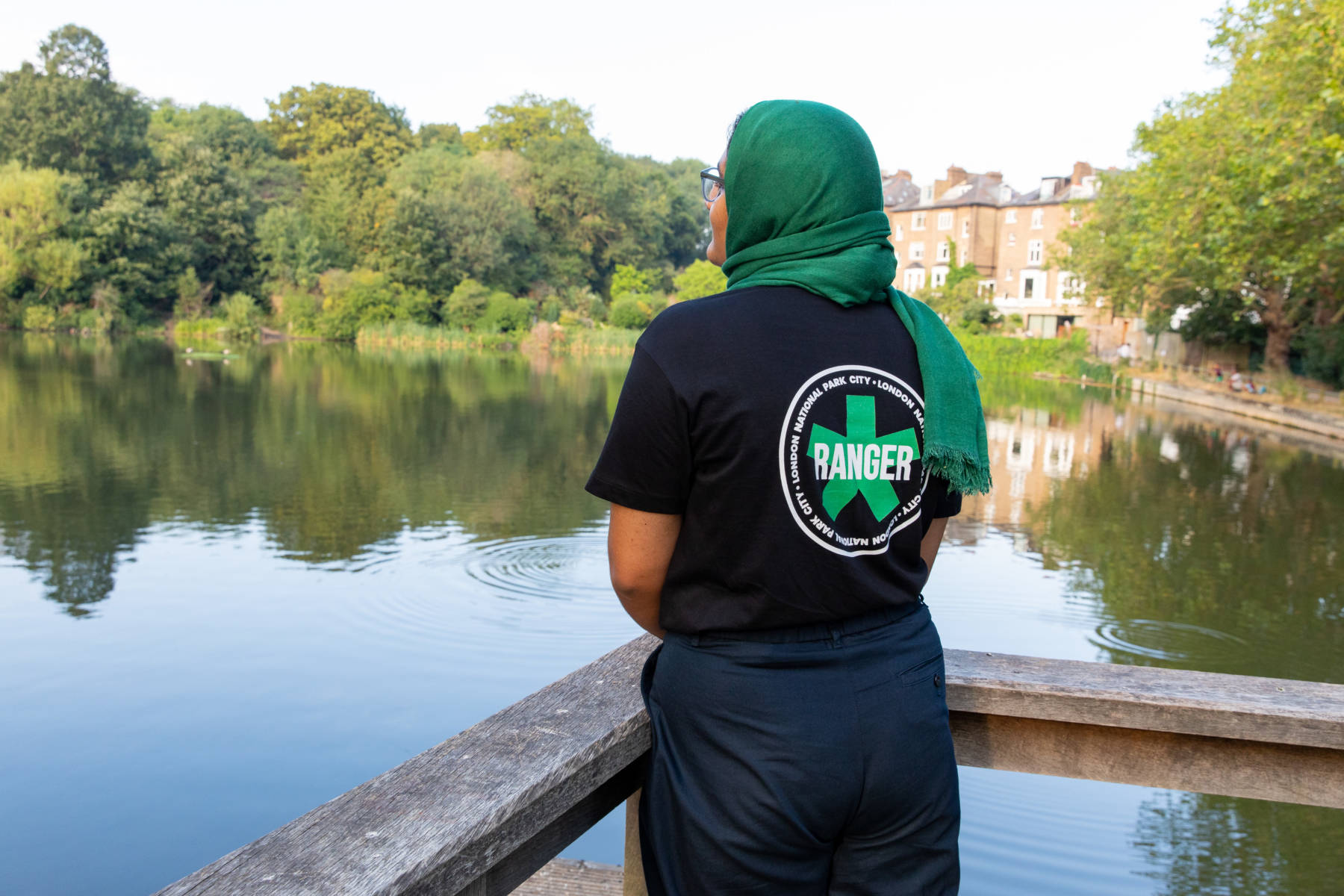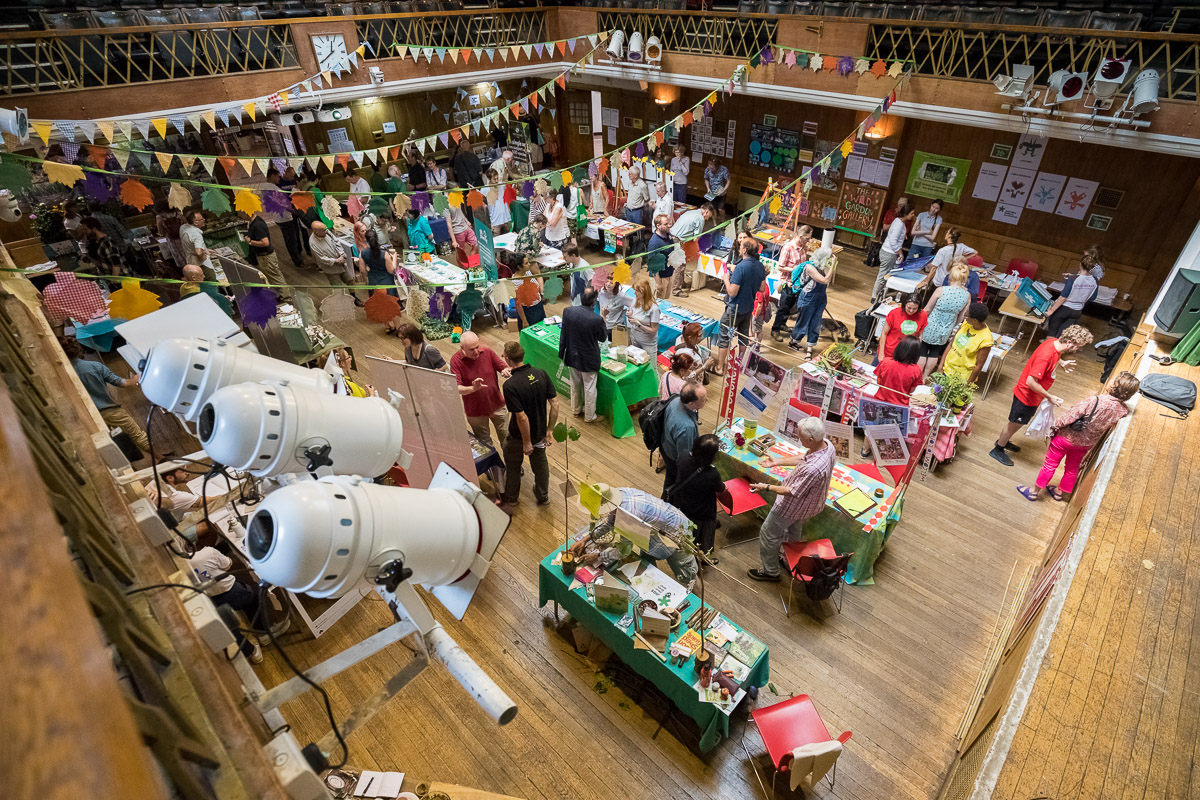“Fundamentally, a national park city is a place that you can explore, you can enjoy, you can improve, you can make better, or you can make worse” he explains. This was strongly illustrated in the London National Park City campaign through the production of attractive and accessible maps and posters. One could argue that there are minimal differences between the visuals created by the London National Park City campaign and the maps available in the ALGG area frameworks, but this would be overlooking how the maps were designed and used.
One of the maps, which was created by Charlie Peel, captures all of London’s green spaces and footpaths into one single sheet of paper, about a metre squared in size, allowing people to see London as one landscape and realise how much of it (close to 50%) is green. Neither the ALGG maps, which are fragmented and embedded within each area framework, or commercially produced maps of London provides such a London-wide picture.
Some of the designs where finalised through collaboration with London-based artists, such as Helen Ilus’ Greenground Map, emulating London’s famous tube map. Such maps were systematically used during the campaign when engaging with wide ranging audiences either in person or via social media. The London National Park City website highlights a range of destinations and experiences London’s network of green and blue space has on offer, all supported by free to download and user-friendly visuals.
“[A national park city] is also a vision that you can share just like with other national parks, a contested vision of hopes and dreams and aspirations for that habitat, that landscape, that community” Daniel Raven-Ellison adds.
The strength of the London National Park City campaign launched in 2013 resides in allowing this vision to be flexible, focusing on consensual ideas around the presence and use of green in the city and question-asking. Drawing inspiration from behavioural change theory as well as techniques commonly used for brainstorming, the campaign made extensive use of “What if…?” and “Why not…?” questions.
For example: “What if things were different because we live in a national park city?”. “What if there were otters in my local canal?”. “What if there are more swings in the park”. “What if there were outdoor learning in schools all the time?”. “What if streets were ten times greener”. “If you ask “what if?” questions inviting people to imagine possible futures, thereby shifting people’s sense of what’s possible in a rather playful, flexible, creative way… and then consider “why not?”, it creates the frustration to find the answer. But if you don’t ask the question, then, the leadership and demand that is needed on a large scale for change to happen isn’t there” explains Daniel Raven-Ellison. In London, this approach proved successful: by 2016, all of the leading candidates in the 2016 London mayoral election announced their support for London to become a National Park City.
By 2018, the campaign had reached its three-fold objective to secure support from: 1) a majority of the elected members sitting in the London Assembly, 2) a majority of the capital’s elected ward teams, and 3) Sadiq Khan, the newly elected Mayor of London. In July 2019, the latter co-signed the London National Park City Charter, setting out key actions to make London a city where people, places, and nature are better connected – which made London the first National Park City in the world.
“Thirdly”, Daniel Raven-Ellison explains, “[a National Park City] is a community. In London we talk about the London National Park City movement, a movement of people…It is about recognising the diversity of people, of cultures, of practices that we have in this great city and celebrating that but also recognising that, just like in rural national parks, we face many challenges and threats as well. But what we have is the firm belief that within this city we have the ideas, the talent, the people to do truly transformative things, improve the quality of not just people’s lives, but also the quality of life of the species we share the city with.”
One of the distinctive traits of the London National Park City campaign was to place a very strong focus on people as the solution, rather than the problem. According to Daniel Ellison-Raven, bringing to the urban environment the landscape-scale approach that defines rural national parks “means everyone is included – whether they know it or not, like it or not…and the challenge and the job is to shift the dials so that more and more people are not only aware but involved and active on agendas making our cites greener, healthier, wilder”. In this journey, culture is seen as the primary medium to engage. “For many people, nature is a niche area of interest. Culture, on the other hand – poetry, music, art, sport and the other ways we behave towards each other – are all absolutely core to our society. It is through culture, storytelling and identity that large-scale change can happen” observes Daniel Raven-Ellison.
The London National Park City festival held in July 2019 to celebrate London becoming a National Park City was emblematic of this approach. It featured over 300 free events held over a week including outdoor theatre performances of The Gruffalo, a ‘Pedal Powered Party’ with live DJs, Living Symphonies, an audio installation set in London’s 6000-acre Epping Forest, and a wildlife photography competition. Attendance exceeded 90,000.
“The fourth part of what a national park city is about, …[a part that is] absolutely vital, is that it is a way of organising. It is a way of coming together, sharing best practices, finding new investment, finding new ways to protect the landscape” explains Daniel Ellison-Raven. London’s National Park City movement is managed by a charity called the National Park City Foundation. Having secured sponsorship from the outdoor wear brand Timberland, the Foundation launched in fall 2019 the London National Park City Rangers programme.
The rangers network is made up of 54 volunteers with diverse backgrounds, areas of interest and locations. It is supported by two part-time ranger coordinators employed by the foundation. The objective is for the rangers to become trusted go-to people in their communities to facilitate projects, educational activities and youth programmes helping to tackle the climate and ecological crises, scale up urban greening initiatives and inspire people to get outside. For example, in Merton, a Climate Emergency Working Group made up of members of the public and set up by the borough is working on a local Climate Action Plan. Members of the group didn’t know a similar initiative was on-going in the neighbouring Borough of Haringey.
The local London National Park City rangers have connections to both projects and might be able to broker a conversation between the two groups and encourage an exchange of knowledge and ideas. The Merton Group also includes a smaller working party focusing on green infrastructure and the local Rangers are beginning to support that work too, considering – with others – how to access funding and advice on how to reach out to landowners. Other initiatives the National Park City Foundation is relying on in London to deliver on its aspiration to become an organising force includes a recently launched school network, and a soon-to-be-announced 100 strong people’s assembly.
“There is a lot going on in London, but it is not as joined up as it needs to be… wouldn’t it be wonderful to have – along with the physical map we already have – a map showing all the groups and the initiatives they are leading?” asks Ben Smith, Trustee at the National Park City Foundation. “We see the National Park City as giving a lot of these groups a voice, and bringing awareness of what others are doing, and connecting people up to make projects happen” he adds. When asked about where he would like the London National Park City to be in five to ten years of time, he explains: “I would like to be able to take my friends on a walk, and show them lots of projects that have been facilitated, catalysed or improved by the National Park City movement and be able to explain to them how these projects are better than they would otherwise be as a result of our support”.
The success of the London National Park City campaign leaves little doubt that its message resonates with people. While excellent campaigning skills and individual charisma played a role, the vision and engagement model it pursues addresses a gap in existing urban greening initiatives through a recasting of people’s relation with nature. Managing to turn this vision into an operational model able to fit in and augment existing systems is not, however, without challenges. “It is harder to hold on of your followership than to acquire it in the first place and getting projects off the ground can be hard work” observes Ben Smith.
The London National Park City movement aims to be a long-lasting approach, one that is not affected drastically by changes in political leadership – just like the national parks found in the countryside. Its operating model, as currently expressed in the London National Park City Charter involves securing local political buy-in and endorsement. Local elected officials are important stakeholders, but they remain one set of stakeholders among many others. Politicians are not expected to own the idea or the process. The National Park City Foundation promotes a strong self-organising bottom-up ethos that does not easily fit within traditional politics.
In London, as would most likely be the case in any other city, the National Park City Foundation is far from the only charitable organisations seeking to enhance people’s connection to nature. Those involved in the London National Park City movement are keen to not take away from any of the grass roots work already underway. They see the movement as a facilitative and augmenting force. Although some of the London-related work, such as the London National Park City Festival were wholly funded by the GLA, the National Park City Foundation has stated it was committed not to pursue public funding so as to avoid diverting resources away from any existing players in the field.
However, the London National Park City movement’s stunning popular and political success, as well as its ambition to increase over time private sponsorship in order to ramp up its activities, can be perceived as threatening. By aiming to be a mobilising and facilitative force, rather than focusing on more contained and recognisable fundraising, rebranding, or campaigning functions, the London National Park City movement breaks a mould found in more traditional initiatives. Creating the sense of safety to secure genuine collaboration will require time, and more examples of successful partnerships and initiatives, but everybody working in climate change and nature recovery acknowledge that collaboration is essential, so perhaps the innovative positioning of National Park Cities can sustain.
One of the National Park City Foundation’s ambition is to facilitate the creation of 25 other National Park Cities across the world by 2025. If successful, this will provide plenty of different contexts to test and explore this new model.


















